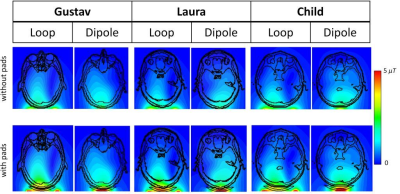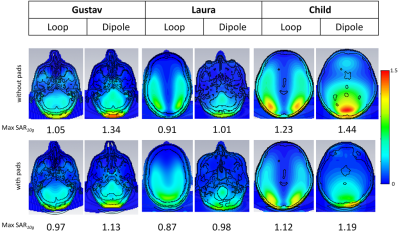4307
Dielectric pads for high-field MRI at 7T: a simulation studyShubharthi Sengupta1 and Alard Roebroeck1
1Dept. of Cognitive Neuroscience, Faculty of Psychology and Neuroscience, Maastricht University, Maastricht, Netherlands
Synopsis
Dielectric pads have been shown to offer a solution to B1+ inhomogeneity at ultra-high fields. We show the transmit field effects and SAR values generated when using shape-optimised high permittivity dielectric pads for visual cortex imaging. Using a single loop coil and a single dipole, electromagnetic simulations were undertaken to validate the use of these methods using 3 different body voxel models, their B1+ distributions mapped and maximum SAR values recorded and compared.
Introduction
A prominent solution to B1+ inhomogeneity at ultra-high field strengths is the implementation of localised RF shimming with the help of high dielectric constant (HDC) pads which have been shown to improve transmit B1 fields over regions of interest (ROI) [1,2]. In this abstract, we aim to validate the use of conformal dielectric pads for localised RF shimming of the visual cortex at 7T with 3 different body voxel models across 2 transmit elements - a single dipole and a single loop – using electromagnetic simulations.Methods
The head-sized dipole and single loop were modelled in CST (CST AG, Darmstadt, DE). The dipole has a length of 20cm and a diameter of 2mm with the feed port and tuning/matching network placed at the middle of the dipole. The rectangular loop has an area of 10 x 12 cm2, with a trace width of 5mm and a thickness of 50μm. Distributed capacitors were modelled as lumped elements along the length of the loop and 2 discrete ports added to the loop. The discrete ports allowed us to place variable tuning / matching capacitors and 50 Ohm terminations in the simulated coil schematic along with predefined capacitors (RLC, series) placed at the lumped element ports along the coil. Both coil elements were placed 20mm away from the posterior ends of the voxel models. The dielectric pads were designed to be 12 x 12 cm2 with a thickness of 5mm, and placed posterior to the occipital pole, conformal to the voxel models’ scalp in the simulation space. The dielectric pads were simulated with permittivity εr = 288 and conductivity σ = 0.36 S/m, similar to that of a BaTiO3 slurry [3]. EM simulations were undertaken for 3 different body models: Gustav, Laura and Child, both with and without the dielectric pads. Both coils were tuned and matched to 300 MHz at 50 Ω, with a S11 of -40dB or better. B1+ fields and Specific Absorption Rates (SAR10g) were calculated for all coil and voxel model configurations.
